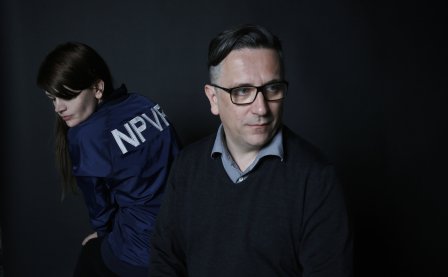At the end of a brilliant and enlightening interview with The Quietus, Factory Floor’s drummer/drum programmer Gabe Gurnsey plainly laid out the bands motto: “Repetition is the platform for free thinking.” This phrase plays out like a mantra, given the way that the syllables crisscross and collide, sliding into the next phrase. Known for their micromanaged and micromanaging tracks, it’s fascinating to see that even their words about themselves are efficient, each phrase and constituent particular effervescent in their appearance and disappearance, yet wholeheartedly lunging themselves into place, forming a whole crystalline and formative structure. With this review, I plan to deconstruct the entity that is Factory Floor, to strip them as bare as they strip their influences and hovering histories.
1. Preliminary Notes on the “Why” of the DFA Label and the “Difference” in Sound
Much issue has been taken with Factory Floor’s signing to DFA, presuming James Murphy’s influence to be acidic and diminutive. But what DFA actually offers Factory Floor is a contextual (or rather contextless) bed from which they can rise. Factory Floor’s releases on Mute/Rough Trade were loaded, codified before they had even reached their listeners’ ears. Suddenly, a list of expectations arose to bear down on what Factory Floor was doing. The music industry has a way of pigeonholing an act once their reference points have been uncovered, and the same happened with their untitled EP. It didn’t help either that Nik Colk had performed with the two surviving members of Throbbing Gristle. But there was a method to this: They wanted their codes. They wanted their DNA structures. Factory Floor, like any good machine, became to evolve and to consume. Traverse as a record, stripped the Mute Records vets of their typically ambient and free-form leanings, trapping them in a liminal environment. The same can be said of their work with Mark Stewart, pinning down his typically theatrical pop satire with a clustered and tautly permuting rhythm section.
Fans have lamented how Factory Floor have slid away from their roots in terms of sonic texture and palette, leaving behind the days of old in which every song would drive itself into a white noise-drenched, doomed affair, cloaks and daggers in hand. They felt that Factory Floor had stiffed them and switched up the game after their collaborations and Richard H. Kirk’s remix of “Two Different Ways.” Even playing with The Horrors and in art galleries leaned to this narrative of Factory Floor being the new carriers of the industrial, post-punk, and dark wave torch.
But they are smarter than that. What DFA does for Factory Floor is allow them to transcend those codes and explore the collisions of high and low through a more “American” perspective. James Murphy’s work with LCD Soundsystem can be best described as a collage or melding of disparate parts: Velvet Underground’s proto-punk, Talking Heads’ worldly minded disco, Brian Eno’s exploration of the expansion of taut pop configurations, the entire genre of electro. This patchwork positioned Murphy as an observer, not as a participator, in the narrative of those artists. This postmodern take is what Factory Floor approach here, a Warholian take on the notion of their significant parts. They yearned to turn the celebrity of the genres and the artist from which they pulled into plastic, malleable material.
2. Factory Floor as an Industrious Mechanism
The self-titled record truly is a full realization of Factory Floor’s prior attempts. For one, the album is far less signifier-heavy, speaking to its own Kraftwerkian structure and codes — body music for the proletariat, body music that actually focuses on the body and not the idea of the body. Stepping away from the theatrics of industrial and darkwave and such, the ease at which the listener is enveloped into such knowing and epistemic music is the true source of fear here, far more so than the ratchet noise bursts of their untitled. The listener is lured into their mechanized state, then reduced and churned out. Factory Floor is about meta-epistemological mechanics, the endorsing of the body and performers as object, not as “I.”
The three of them — Nik Colk, Gabriel Gurnsey, and Mark Harris — are not interested in the significant particles of industrial music; they aren’t even concerned with its history or its influence. They are concerned with its function: How does a machine work? What makes something industrious? Factory Floor elevate the notion of the industrial, the form and function of the factory, and they apply it to man’s inability to become readily mechanical, man’s ultimate inability to be efficient. To be industrious is to churn out products as quickly and efficiently as possible, each step of the way until the result is a tangible product and in the now. Factory Floor is an acting thing, as opposed to a thinking thing. Through the untiring driving force of a repetition, thought breaks down and enlightened thinking emerges; the more space collapses, the more it frees itself. This is extremely evident in the standout of the bunch, the newly definitive version of “Two Different Ways,” a warped amalgamation of the two versions that were released in 2011. “Two Different Ways” begins in strong, propulsive halftime with a live kick drum and chopped-up snare combo, as plushy, erratic synths cycle and frolic above it, intermittently locking into place with the drum pattern every other measure, never in the same way or at the same angle. This type of succinct construction is exactly what warehouse techno strove to do. Skittering drums load the bottom end as the synths become more violent and more focused; Void coos, “Two different ways to let it back in.”
As stated above in the introduction, I have characterized the beginnings, the pioneers of the Factory/Industrial records, to be referents of the Western envelopment of the world, the Western high (that is, prepared, sanitized, and production-ready) art colliding and galvanizing the rest of the world’s low inherent culture. Factory Floor’s creation of a pop song speaks to their ability to be a machine, and a machine must be able to create efficient (sellable) things. In tracks like “Here Again,” with the collision of Michael Jackson (circa Off the Wall) vocal melodies and the wound-up rhythmic structures of techno through the focused lens of Neu!, a definably 80s guitar lick is frozen in place and then panned around the stereo field equaling perfectly relational, metamodernist music: a product that is a universal form made up of separate, independently functioning parts.
3. Nik Colk Void as China Girl
“Flesh needs to resemble flesh. It has a norm, a referent: the China girl […] Some of the China girls smiled. Most stared into the camera with a faint, taut bemusement just under the surface of their expressions. Who knew I’d be a model? But here I am, modeling flesh tones. […]
“…certain women were best viewed from the window of a speeding car, the exaggeration of their makeup and their tight clothes. But maybe women were meant to speed past, just a blur. Like China girls. Flash, and then gone.”
– Rachel Kushner, The Flamethrowers
The China Girl is momentary, solitary, and elusive. She is a moment, subliminal and beautiful when wedged in between spaces of time. It is the absence and the distance of Nik Colk’s voice that asserts the frightening qualities upon which Factory Floor is founded — which is, once again, not the blasts of white noise and destroyed guitar wails of old.
In There Is Love In You, Four Tet seems to oogle and caress the female voice, raising it up to spiritual heights. As heard on tracks like “Angel Echoes” and “Love Cry,” Four Tet places the single female vocal in the center of his tracks, as the lead. We watch as the tracks unfurl, sunlight seeming to dwindle and then shine as the unknown woman bathes in the light, dancing among its rays: true spiritual elevation. Factory Floor have always done similar things in the past, placing Colk against Dom as heard in tracks like “Lying.” Back then, those were simple meditations of phrasing and intonation over a span of time. Here, those ideas have advanced very acutely. Each track here brutalizes the sensual elements of Colk’s vocals, elongating and tearing it at the points where the lips pucker, when inhalation ceases. There is a strange distance there, the three of them staring down on her discarded vocal, as it is being torn by contracting time throughout each merciless track.
“Fall Back” starts immediately, winding itself up, Void sighing out the title as though completely bored or disinterested. Closing track “Breathe In” is stilted disco leaning into Metal Box-era Public Image Ltd. The tracks struts along, stately and bold, but Colk in the center sighs in exasperation, making the track feel sluggish, a sort of inversion of a Chicago house trope: the soulful diva figure — the female to be adored, the emotive hook — is steely and resigned, as opposed to lurching forward, lunging her emotion at the listener. Colk is no diva. She is the unwilling American Apparel model, the woman caught by an admiring onlooker. She knows not that they are there. Thus, the space between collapses. Colk is then a wistful object that doesn’t participate in objectifying (in terms of its materiality) her own being; she allows herself to become a product as the production wheel and the observers perceive it/her to be.
Conclusion:
What makes this record so interesting is the way that Factory Floor crunch down vintage, codified sounds and textures and shoot them through liminal time. This is truly industrious, the capturing, packaging, and selling of cultural codes. If Factory Records signified the West’s overtaking of the world and all that is material and natural, then Factory Floor is that capitalist ideal personified. This homogeneously motley collection of tracks is a high-art translation of tech house norms, a metronomic warehouse-tinged mutant of a record. This record is not so much a thumbed nose aimed at the hapless fans of the idea of industrial, so much as it is Factory Floor understanding their own contextual space and developing a more objective version of what they have taken in, asserting and outputting what Steve Oklyn (of NOT VOGUE fame) would call: COUNTERCULTURE VS OVER-THE-COUNTER CULTURE (OPPOSE DISRUPT DISAPPEAR).
More about: Factory Floor




